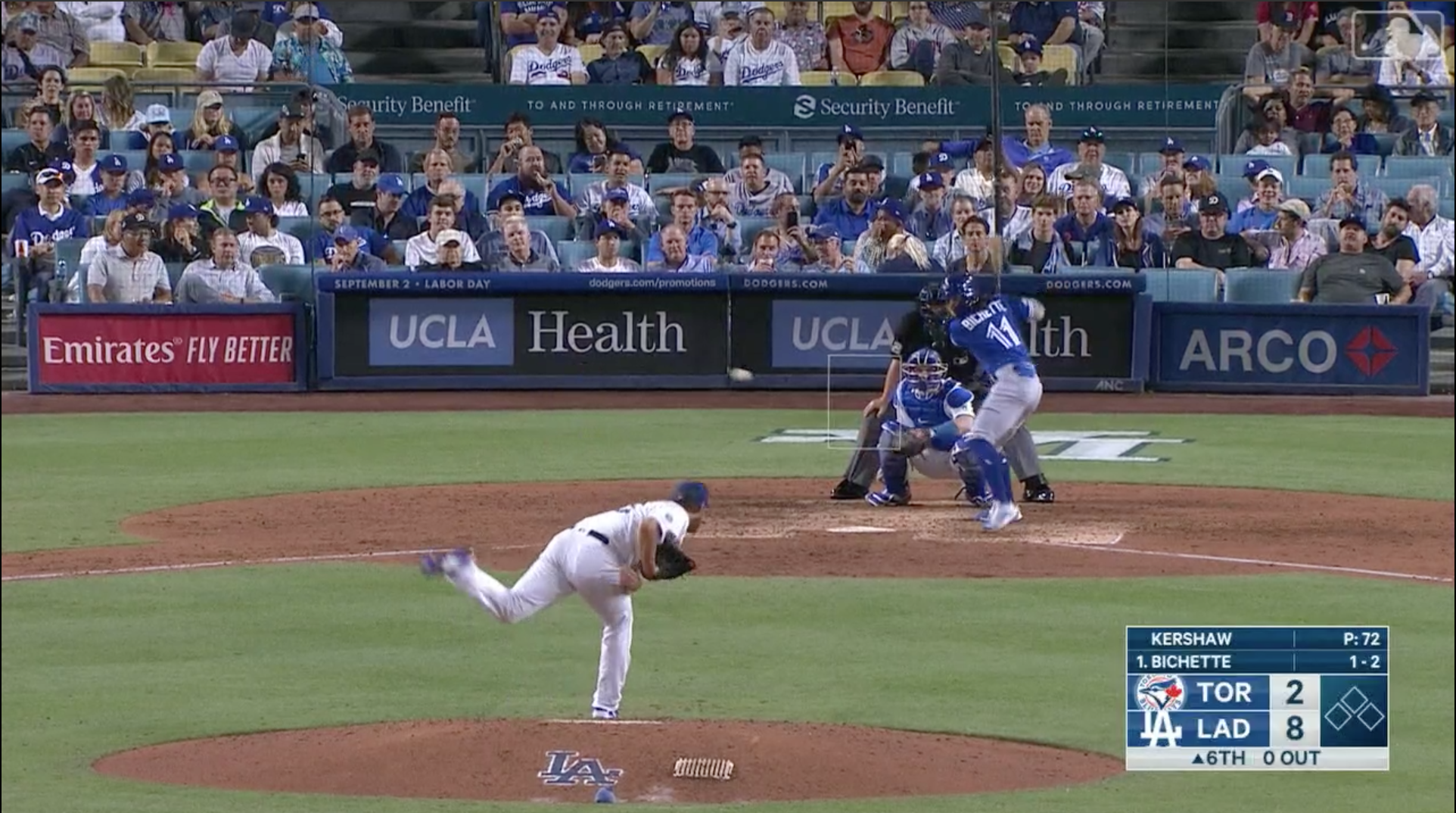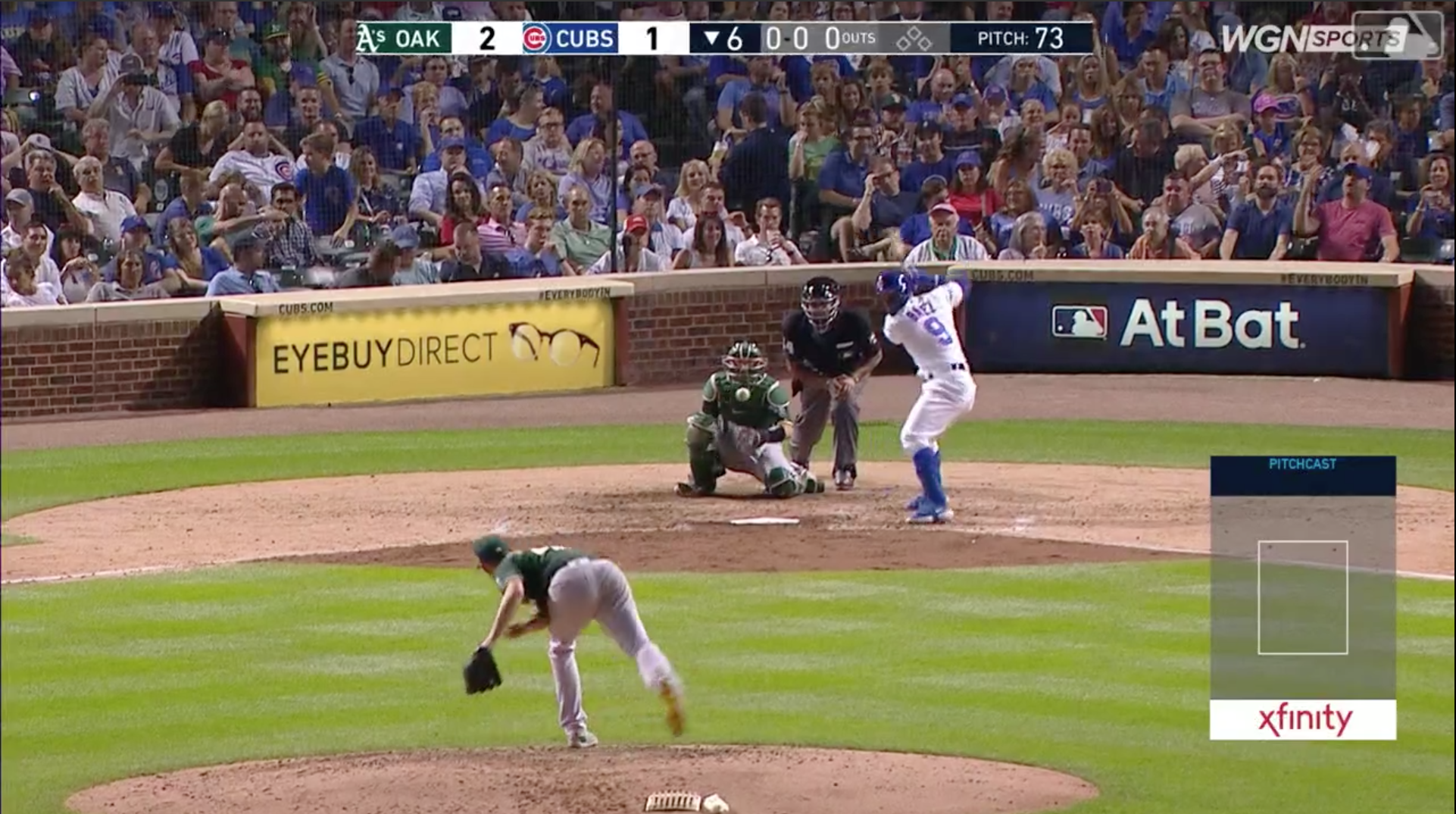Bo Bichette has come a long way. Drafted in the second round of the 2016 MLB Amateur June Draft from Lakeland High School in St. Petersburg, Florida, Bo was not initially thought of like the prospect he is now. He was cited to be in the upper 40 Future Value (FV) tier – roughly an average to below-average prospect – largely from concerns over his funky swing and rather middling defensive ability – his older brother Dante Bichette Jr. not living up to the first round hype several years earlier also caused for some unfortunate negative bias. Though for a high school player, a lot of these concerns as valid as they may be, are certainly not enough to knock a bloke off entirely. Bichette continued to just do enough with the glove to stay at short, while the bat absolutely exploded throughout the Minors. He was able to change the minds of those who evaluated him, eventually becoming a 60 FV prospect – a budding star. He’s lived up to every bit of that ranking even though he was the last of the three top Toronto Blue Jays super-prospects to get to the big leagues. Though, as they say, the best is for last – certainly for production so far anyway. Teammates Cavan Biggio and Vladimir Guerrero Jr. have struggled for a majority of the season, the latter finding his footing for this recent stretch since the All-Star Break. It has been Bichette, only recently called up, that has been absolutely tattooing the ball and sending it to all parts of the park – just ask Clayton Kershaw. As Bo ascends to greatness, we still do not judge players on a nice run, particularly when it has not even been a month. What can we realistically expect Bo to be?
Bo Knows Hitting
As Bo lights up the league with his .341/.388/.703 slash line, with a .450 xwOBA, one area of concern has been his fairly poor rate of chasing pitches outside the zone – if you add that Bichette has a fairly unique and long swing through the zone, then it sums up to a glaring weakness of potentially prolonged slumps. Though it does not mean that he can’t continue to have success with the bat and become one of the top players at a very deep position. We’ll play a guessing game to base our future outlook.
Here, are the plate discipline metrics for two players – one is Bichette and the other our ‘mystery’ player – both play shortstop.
| O-Swing% | Z-Swing% | Swing% | O-Contact% | Z-Contact% | Contact% | Zone% | SwStr% | |
| Bo Bichette | 38.7 | 72.7 | 51.4 | 71.1 | 79.8 | 75.7 | 37.4 | 12.5 |
| Mystery Player | 44.0 | 74.7 | 55.3 | 54.2 | 81.1 | 67.6 | 36.9 | 17.8 |
As we see, both players have ultra-aggressive approaches yielding quite a bit of swing and miss. The difference between Bo and our mystery player really comes down to O-Contact%. Bo has done an incredibly good job of making contact on pitches outside the zone, likely keeping his swinging strike percentage lower than our mystery player. Now, you guys have probably waited long enough – who is our mystery player?
The answer is Javier Báez. Báez is renowned for his free-swinging approach that has resulted in powerful impacts when he’s connected. Though, prolonged stretches of a plethora of strikeouts with minimal impact have always held Báez back from becoming one of the most dynamic right-handed hitters the game has seen.
Both players provide ordinary contact percentages which actually comes from similar swing mechanics. Look at both Bichette and Báez’s bat heads just prior to exiting the load, respectively.
In both cases, the end of the bat points directly at the pitcher just prior to the start of the swing. The bat being coiled fairly far behind the head means it has a long way to go before finally entering the zone. With higher and higher velocity in today’s game, that’s not exactly a template for success. Though if your hands work at lightning speed, as in the case of Baez and Bichette, you can get away with it. Generating that much torque through their swing allows both players to have fairly high hard-hit rates, however, it makes plate discipline equally as important – it’s very difficult to check such a violent swing.
With Báez’s current approach at the plate, he regularly and swiftly subjected to a number of plate appearances that end in a strikeout. For every player, there is always a hot streak and a slump around the corner. The great players have their hot streaks, but they also know how to limit the damage during a slump. For Báez, his plate discipline makes slumps far more destructive than they should be – and that’s what limits his hitting potential.
For Bichette, controlling the strike zone is paramount. Báez can continue to be the happy go lucky slugger he has been because he’s ‘El Mago’ (the magician). Easily one of the best defensive infielders in the sport, Báez will get that leash at the plate because of how special that glove is. Bichette won’t have that same leash because of a fairly average glove. Remember how overlooked Xander Bogaerts became prior to the 2018 season? Even with Toronto being a rebuilding club, giving Bo every opportunity to become a superstar, Bichette will need to hit at a solid clip to not end up an afterthought in baseball lore.
Bo Knows Two Strikes
Many of you have most likely noticed Bichette’s two-strike approach.
Bichette elects not to go to his high leg kick, rather coiling his front foot, which makes it easier to make contact with two strikes. This would seem to help Bo in the future to quell strikeout issues from getting out of hand. The results are unique, and we compare them with Javier Báez once again.
| xwOBA | xwOBACON | Contact% | O-Swing% | SwStr% | |
| Bo Bichette | .220 | .300 | 51.06 | 34.29 | 15.11 |
| Javier Báez | .253 | .517 | 39.38 | 40.41 | 21.23 |
While Bichette and Báez have very similar styles at the plate overall, the two hitters diverge with two strikes as the former clearly makes a concerted effort to make contact and limit swing and miss while the latter does not. However, Báez makes stronger contact with two strikes, something Bo could likely achieve if he did use his leg kick with two strikes.
While it would be nice to see Bichette hit the ball harder with two strikes, his approach is fine as is and he’ll continue to learn the strengths and weaknesses of his two-strike swing to then hopefully end up hitting the ball harder.
Bo Knows Fantasy Baseball
As great as it is to predict what Bichette might do years from now, we now progress towards the end of the fantasy baseball regular season and into the playoffs. There are fantasy championships on the line. With that said, Bo likely will have a fairly large role to play for the many owners that have him rostered.
Here, we can see Toronto’s schedule over the remainder of the season.
| Games | |
| Week 21 | 2 v ATL, 3 v HOU |
| Week 22 | 2 @ ATL, 4 @ TB |
| Week 23 | 3 v BOS, 3 v NYY |
| Week 24 | 3 @ BAL, 3 @ NYY |
| Week 25 | 3 v BAL, 3 v TB |
Now, before we know what this means, we need to know Bo’s weaknesses, particularly by pitch.
| Pitches Seen% | xwOBA | |
| Four-Seamer | 35.9 | .479 |
| Slider | 22.4 | .309 |
| Sinker | 13.7 | .304 |
| Curve | 10.2 | .387 |
| Cutter | 9.5 | .246 |
| Changeup | 8.0 | .514 |
| Split Finger | 0.2 | .217 |
Two pitches stand out in Bichette’s results so far – the slider and sinker. Of course, the sinker is a declining pitch in today’s game, so I would not give it that much thought.
The slider, on the other hand, is an incredibly valuable pitch, and one that many staffs now base their success off of as a devastating chase offering.
| Pitches Thrown% (Team Rank) | xwOBA (Team Rank) | |
| Atlanta | 17.6 (17th) | .266 (12th) |
| Houston | 19.4 (13th) | .236 (1st) |
| Tampa Bay | 13.5 (27th) | .274 (20th) |
| Boston | 16.2 (21st) | .272 (16th) |
| New York (AL) | 20.8 (7th) | .255 (5th) |
| Baltimore | 21.4 (5th) | .308 (29th) |
In the first couple of matchups next week, Bichette most likely faces Mike Soroka and Mike Foltynewicz, both with very good sliders so that should be something to keep an eye on. As for Houston, Bichette should run into Wade Miley, whoever replaces Aaron Sanchez in the rotation – seems to be Framber Valdez – and Justin Verlander.
Our second to the last chart does not show us is the difference between lefties and righties for each of those pitches thrown. For Bichette, he’s mashed to the tune of a .625 xwOBA against lefty sliders, while only hitting a paltry .192 xwOBA against the same pitch but from the other arm. This should make him a fairly good option against Miley and Valdez, though Verlander might give Bichette fits – though that happens to almost every hitter that faces the future Hall of Famer.
Tampa Bay and Boston generally throw four-seamers and curveballs, staying away from the slider, so Bichette should be able to have nice series against both teams – especially with Boston now missing Chris Sale and Tampa Bay missing Blake Snell and Yonny Chirinos – meaning he’ll likely be facing a sub tier set of arms as to what both teams normally throw out there.
In the final couple weeks of the season, excluding a series against the New York Yankees, Bichette gets to face the Baltimore Orioles in a couple of series – even though they throw the slider at the fifth-highest rate in baseball, its xwOBA is second-worst in the league. This should allow Bichette to overcome his inefficiencies against the pitch and continue to destroy the Orioles as he has so far.
Overall, there’s a lot to like about Bichette’s schedule going down the stretch, and there’s a good chance he delivers nicely, leading to a number of fantasy championships.
(Photo by Brian Rothmuller/Icon Sportswire)




This is one of the better deep dives I’ve seen, especially the pitch and schedule breakdown at the end. Great work!
Thanks for the kind words – I’m glad you liked it!